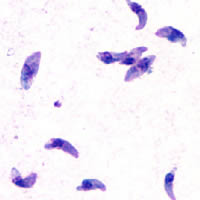
Photo from wikipedia
PURPOSE Toxoplasmosis is a zoonotic infection linked to compromised hygiene and sanitation via the handling of infected cat faeces, eating undercooked contaminated meat or transplacental transmission. We conducted a study… Click to show full abstract
PURPOSE Toxoplasmosis is a zoonotic infection linked to compromised hygiene and sanitation via the handling of infected cat faeces, eating undercooked contaminated meat or transplacental transmission. We conducted a study to determine seroprevalence and risk factors associated with toxoplasmosis among the urban poor communities in Malaysia. METHODS The demographic profiles for each participant were obtained through a questionnaire survey prior to blood collection. A total of 389 participants were recruited and blood samples screened for the presence of anti-Toxoplasma IgG and IgM antibody using an ELISA commercial kit, SERION ELISA classic Toxoplasma gondii IgG and IgM. RESULTS The overall T. gondii seroprevalence was 69.6% with 56.8% seropositive for anti-Toxoplasma IgG, 7.7% seropositive for anti-Toxoplasma IgM and 5.1% seropositive for both IgG and IgM antibodies. The presence of both antibody classes in blood samples indicated high avidity, suggesting latent infection. Univariate analysis revealed significant associations that included; age, ethnicity, location and employment status while, significant lifestyle factors included source of drinking water and eating style. A multifactorial statistical model that incorporated all the significant effects from the first-stage univariate analyses listed above revealed that age and ethnicity were the two dominant and independent effects on IgG seroprevalence. For seroprevalence of IgM, the multifactorial model revealed a significant interaction between work and accommodation. IgM seroprevalence was higher among the unemployed inhabitants of PPR (Program Perumahan Rakyat) than those living in non-PPR accommodation, and higher than among the employed irrespective of their accommodation. CONCLUSION High seroprevalence of Toxoplasmosis in the community calls for increased awareness of disease transmission and improvements in hygiene and sanitation.
Journal Title: Acta parasitologica
Year Published: 2020
Link to full text (if available)
Share on Social Media: Sign Up to like & get
recommendations!